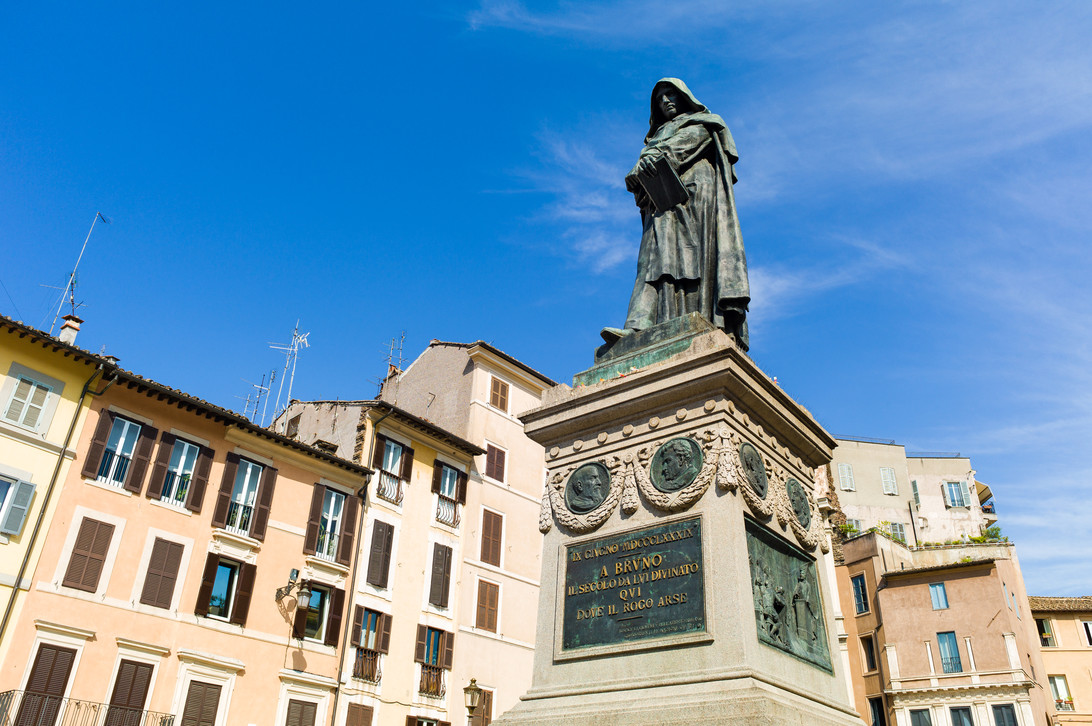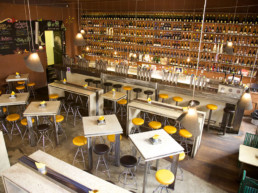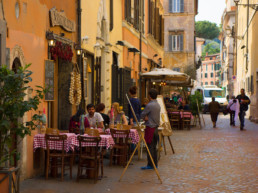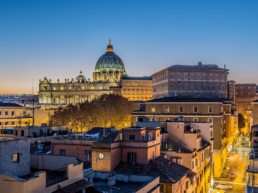Campo de’ Fiori is a focal point of Rome with all walks of life transecting this lively square: aging Italians making their rounds to purchase local produce from the market stalls, weary tourists checking off the next item in their guidebook, and Roman youth getting their night started once the sun sets.

For centuries Campo de’ Fiori has been a gathering point for Rome’s residents, both dignitaries and the working class. During the Renaissance the square was the location of both a popular horse market and public executions. Today, Campo de’ Fiori is dominated by the ominous statue of Giordano Bruno, whose hooded face overlooks the square from the spot where he was burned alive in 1600.
Located in Rome’s centro storico, or historic centre, Campo de’ Fiori is right in the heart of the eternal city. Situated between rion Parione and rione Regola, the square is near the Tiber and a short stroll from sightseeing classics like Piazza Navona, the Pantheon, and Largo di Torre Argentina.
While there are some excellent dining spots near Campo de’ Fiori, the restaurants that line the periphery of the square are largely disappointing. Catering mainly to tourists, many of these establishments sacrifice quality and fall far short of Roman dining standards. Although these restaurants aren’t a bad spot to enjoy a quick drink while taking in the commotion of the square, head out of the piazza when it’s time to eat.
Where to eat near Rome’s Campo de’ Fiori
A short stroll from Campo de’ Fiori along Via dei Giubbonari is deli-meets-restaurant hybrid Roscioli. Run by a family with multiple generations in the Roman food scene, Roscioli is a culinary institution in Rome. Though the food is more upmarket than your classic trattoria, Roscioli resembles a deli with a huge counter displaying meats and cheeses, where tables and chairs have been squeezed into any open space. Service is succinct and efficient, which may lead some visitors to feel brushed off, but the staff knows its stuff inside and out. Roscioli’s burrata covered with sweet and juicy sun dried tomatoes is out of this world good, as are their classic pasta dishes such as the carbonara and amatriciana.
#domenica #sera #pizza #lavecchialocanda ❤️
A photo posted by La vita è una e la vivo così? (@stefanoquartieri) on
On the other side of Corso Vittorio Emanuele is La Vecchia Locanda. Although set in a rather unassuming location and tucked away in an alley, La Vecchia is the quaint trattoria you can envision making your local spot if living in Rome: small, dark wooded cellar-like interior with dim lighting and bottles of wine stacked against the walls. La Vecchia offers some of the best traditional Roman fare in the entire Centro Storico from pastas executed to perfection to ultra fresh seafood and meats. Another solid feature of La Vecchia is its consistently good service, which can be somewhat of an anomaly in Rome.
Black truffle pasta #tavernalucifero #truffle #happybelly #happyfoodie
A photo posted by antigone03 (@antigone03) on
Down the narrow, cobblestoned Via del Pelligrino is the charming Taverna Lucifero. The owner Lilo welcomes you as if you were close friends dining in his home, taking the time to explain everything on the menu and helping to select a wine off the wall to perfectly compliment your meal. The fondue, one of Taverna Lucifero’s specialities, is a popular choice with a range of dipping options as well as the rich pasta tartufo that comes with a generous heap of freshly grated black truffle. Save room for dessert, for which I highly recommend the delectably sweet chocolate fondue with fruit.
A photo posted by Gezici Günlük (@gezicigunluk) on
A nondescript door on the south-west corner of the square leads into acclaimed bakery Forno Campo de’ Fiori. A carb lovers dream, Forno offers a plethora of baked goods from pastries and cookies to fresh breads and cakes, but what really draws people in is their spectacular pizza. The moist and chewy crust is the perfect base for the simple yet delicious toppings like zucchini, squash, and potato. Forno’s baked goods are a hot commodity so come early in the day to avoid disappointment.
A photo posted by Simone Bonini-Gelato Carapina (@simonebonini) on
A new addition to the gelato renaissance happening in Rome is Carapina Gelato, a highly acclaimed export from Florence that is a hop, skip, and a jump from Campo de’ Fiori. Using only the best ingredients while avoiding all of the fluff and filler that is increasingly common in gelato shops across Italy, particularly those in tourist hotspots, Carapina serves up some delicious treats. With a rotating selection of flavours, expect well crafted classics such as peach and hazelnut alongside more unusual concoctions like watermelon or parmigiano reggiano.
A photo posted by Open Baladin (@openbaladinroma) on
For craft beer enthusiasts, Open Baladin is the perfect addition to a food and drink tour of Campo de’ Fiori. This popular beer bar opened 2009 and has quickly become home base for local craft beer aficionados, expats, and travellers alike. Owned and operated by Baladin, an Italian brewer and operator of a growing network of brewpubs across the country, Open Baladin features over 100 Italian beers alone with 40 local craft beers on tap including Baladin’s own line. While there are an increasing number of spots to enjoy craft beer in Rome, this is a great place to get your bearings and try a broad swath of beers from Milan to Palermo.
Every day except Sunday, Campo de’ Fiori is transformed into a bustling, open air market with vendors selling seasonal fruits and vegetables from nearby farms, vibrant bouquets of flowers, rows upon row of practical and exotic spices, and unfortunately, due the market’s popularity, the obligatory tacky tourist stuff. The market has experienced some difficult times in recent decades causing many of the traditional vendors to leave, however there are still some regulars holding down the fort.
Campo de’ Fiori photos courtesy of Flickr, Roberto Taddeo, Alessandro Grussu; Instagram
Make your next trip the best one.
Departful is a full service travel agency creating truly exceptional travel experiences that are 100% personalized to you. Wherever you’re going, whatever your interests, we help you plan the perfect trip.
Lauren
Lauren co-founded Departful in 2012 and is the Managing Director of Departful Media. Since then she has worked between North America and Europe and has published content in partnership with a variety of tourism boards and businesses based around the world. Lauren is currently based in Toronto, Canada.




